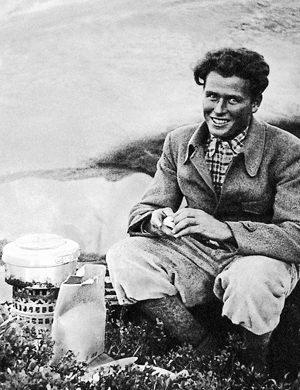The North Face of the Eiger
‹ Return to Berlin

1936 attempt on the North Face of the Eiger
Not an old postcard this is a photo taken during a hitching and hiking trip around the Alps in July 1986, exactly 50 years after the events described here.
I had read about the Swiss mountain’s near vertical 6,000 foot north face and the men who pioneered climbing routes up it in Heinrich Harrer’s book ‘The White Spider’ and wanted to visit the place.
This is probably the most famous story of all, the tragedy that befell Toni Kurz and his companions in 1936.
The Context
Summer 1936. In Germany, Hitler had been in power for 3 years and the government was preparing for the Berlin Olympics. In the Alps, most of the summits and routes had been climbed leaving just the Eiger Nordwand as the ‘last problem’ of Alpinism.
A German team solving this last problem would be a chance for the Nazis to capitalise and claim the glory. Hitler had mentioned a Gold medal for the first team to make it to the summit.
It isn’t easy when your heroes hail from history’s darkest corners. I don’t know whether the mountaineers were Party members or not but the Germans in this story were from Berchtesgaden in Bavaria, a region sometimes called the ‘cradle of National Socialism’. Hitler had his country retreat there and the region was very much at the heart of his ‘Völkisch’ ethnic ideology which led ultimately to the Holocaust.
Below; Then and Now. Berlin’s Olympic Stadium in 1936
For more on these Olympic Games, please click here.

The North wall of the Eiger was generally considered unclimbable. Constantly swept by storms, avalanches and falling rocks, Swiss mountain guides said they would not rescue anyone who ventured onto it and those that did were considered ‘mentally deranged.’ The previous year had seen two German climbers perish in the cold sat on a ledge known since as ‘Death Bivouac’.
The Nordwand did get visitors though; an electric railway high in the mountains had been tunnelled 30 years earlier, enabling tourists to peer down from station gallery windows cut into the face and from which spoil was dumped as the Jungfraubahn tunnel was built.
The Climb
Beyond the politcal spin and the media interest and the tourists wanting to see drama played out through telescopes trained on the North Face, two German climbers, Andreas Hinterstoisser and Toni Kurz, and two Austrians, Edi Rainer and Willy Angerer, left their tents in the meadow below the face on July 18th 1936 and started to climb.
Toni Kurz, a professional mountain guide, photographed July 1936 just before the climb

Andreas Hinterstoisser, the German climber who led the way

Austrian Alpinists Edi Rainer and Willy Angerer

The two seperate ropes naturally joined forces and climbed together. They soon reached an obstacle, a slab of smooth and slippery rock. Hinterstoisser climbed above to fix a belay, then was able to traverse the obstacle to the other side. He fixed a rope for his pals to clip onto and created what has since been known as the Hinterstoisser Traverse. Once the others had crossed, Hinterstoisser retrieved the rope, thus sealing their fate; there was no way the traverse could be reversed without the rope in place.
They continued to climb well but before their first bivouac on the mountain, Willy Angerer was injured, probably by a falling stone (this was in the days before climbing helmets, they just wore felt hats). They pressed on but by the 3rd morning and just below the Death Bivouac it was obvious Angerer could go no further. With their comrade unable to continue the mission was no longer to climb but for all 4 to get back down. As they slowly descended, the weather began to deteteriorate. With soaked clothing and low spirits, it must have been a miserable fourth night on the mountain.

The original photo of the North Face from Wikipedia Commons.
The End
On the morning of the 22nd July, those following their retreat from below could only catch glimpses between breaks in the cloud.
Hinterstoisser was leading the way when he came to the end of the traverse and from which he had retrieved the rope. Without it they could not cross. Hinterstoisser tried to find a way back but kept slipping off the smooth and now ice covered rocks. He had no choice, the only way was to abseil down an overhang and into the unknown cloud shrouded void beneath them. Somewhere below was a system of ledges which would lead to a Jungfraubahn gallery window.
Their situation was desperate, but then they heard a voice calling to them; it was a railwayman at the gallery window just a few rope lengths away! He heard them yodelling back. All was well, they said, and they would be down soon. The railwayman returned to his room and got some tea brewing with which to welcome the lads.
They never made it there; an avalanche apparently crashed into the party shortly after. Andreas Hinterstoisser, who seems to have been off the rope at the time, was swept off the face. He fell 2,000 feet to his death. The other three were also pulled from the mountain, but their belay piton held. The already injured Willy Angerer was smacked hard against the rock, an injury which probably killed him outright. Above him and with the full weight on the other two on his torso, Edi Rainer was pinned against the wall and was asphyxiated within minutes. Only Toni Kurz was left, hanging between the two bodies of his pals.
The railwayman went back to see where they had got to after a couple of hours and heard Kurz calling for help. He phoned a party of guides who travelled up by train and climbed out of the window and made their way to him, ignoring their self imposed ban. Alas they could do nothing for Kurz in the storm, he was too far above them and out of sight beyond the overhanging rock. They said they’d be back in the morning and with Kurz begging them to stay, they returned to the railway station.
The view down the near vertical Face to the meadows and woods 2000 feet below. Photographed from the station window in 1986, it is close to where Toni Kurz was hanging on a rope over the drop and is as close to the North Face as I am likely to get

The next day, the weather had cleared and the rescue party was amazed to discover Toni Kurz had somehow survived the night. He had lost a mitten at some point and his left hand was a frozen lump.
They instructed Kurz, who had insufficient rope to descend, to climb down to Angerer’s body to cut him free, then climb up to do the same with Edi Rainer, to acquire some bits of rope. Using his one good hand and his teeth, he managed to unpick the threads of the hemp rope he gathered and tie them together. Hours later, after an unimaginable effort, he lowered this thin line down. The rescue party attached another rope to this and called to Kurz to pull it back up. The rope they had was not long enough, so another was tied on to the end.
Kurz then clipped onto the new rope using a snap link. As he inched down and into view of the Swiss guides, he saw the knot tying the ropes together, knew it was too big to pass through the snap link and that he could descend no further. He was almost within reach of his rescuers and they could just touch his boots with an outstretched ice-pick. The rescue party urged him on, imploring him to force the knot through, but he could do no more. Finally Toni Kurz announced “I’m finished” and slumped forward and died. His body was cut down after a few days and later recovered from the foot of the face.
The body of Toni Kurz hanging from a rope within inches of his rescuers.

The North Face of the Eiger was successfully climbed two years later by two Austrians and two Germans who again joined forces; Heinrich Harrer (who was played by Brad Pitt in the movie Seven Years in Tibet ), Fritz Kasparek, Andreas Heckmair and Ludwig Vörg.
More
Chris Frick’s outstanding set on Flickr documenting an ascent of the North Face via the 1938 route in 2005.
www.flickr.com/photos/35197167@N02/sets/72157615514569924/
For a quick view of the Eiger North Face, this two and half minute video is from a camera attached to the helmet of a ski-glider who starts from the summit, down the West face (on the right in the photo above) and out onto the North face about 1/3 of the way down.
Nazi propaganda colour film for visitors to Berlin for the 1936 Olympics.
35 comments on “The North Face of the Eiger”
1 Pings/Trackbacks for "The North Face of the Eiger"
-
[…] For more information on this, see here. […]
Leave a Reply Cancel reply
Image Information
-
Full Size: 1423×949px



Excellent info and a great image well toned..
brilliant ian , i read about this some yrs ago, when i was into to rock climbing (many yrs ago) nearest i got to a mountian was cadar idris in wales the weather changed when we was half way up and that was bad sleet ,hail rain, we had had enough so i can just imagine those poor souls on the eiger
Nice touch Ian, i know the story well. Even had the intention of climbing the North Face of the Eiger before i reached the age of 50. (still possible)
I have a couple of mates who have climbed it.
Reinhold Messner made an amazing ascent of the Eiger some years back.
en.wikipedia.org/wiki/Reinhold_Messner
Great subject.
Nice touch Ian, i know the story well. Even had the intention of climbing the North Face of the Eiger before i reached the age of 50. (still possible)
I have a couple of mates who have climbed it.
Reinhold Messner made an amazing ascent of the Eiger some years back.
en.wikipedia.org/wiki/Reinhold_Messner
Great subject.
[http://www.flickr.com/photos/nondesigner] [http://www.flickr.com/photos/29730035@N04] [http://www.flickr.com/photos/42423575@N00]
Thanks all. It is a well known story among climbers.
Impressed to read that Andy, think you will ever give it a go then? The North Face is far too technical for me, always out of my league. A slog up Mont Blanc in 1999 and a couple of easy summits in the Alps has been the extent of my climbing. Reinhold Messner is a legend.
Epic stuff Ian.
You’ve put a lot of effort into this.
Fascinating.
Yeah great story Ian well told , I have heard of it before , indeed I do believe we have talked about it ourselves 🙂 , Its a tremendous mountain and its almost 20 years now since i last visited the area …time for another trip there I think ……that railway to the top is fantastic and a great way to experience a real mountain the easy way !
It stops so that passengers can have a look out and down the face of the Eiger !
Interesting stuff Ian. I first learnt of the story through the film Nordwand (which I enjoyed, despite its elaborations)
Excellent all round article and shots..Really well done.
Indeed tragic… So close…
Quite a story and although I had heard some, I didn’t know anything like this. It looks an amazing place – and I am definately not a climber!
Great narrative Ian – sad ending, so close yet so far!
Tragic indeed. Like Bill said, the narrative is just great. Learning a lot of things with your work, Ian.
Impeccably presented, well researched and interesting piece of detailed work Ian. I used to climb trees full time as a living, not too sure about mountains though. Fascinating that you have tackled some challenges of your own too 🙂
really interesting stuff
[http://www.flickr.com/photos/reflectionsreturn] what Mark said .. apart from me climbing trees for a living. climb trees yes, but never thought i could get paid to do it lol … that said, i just had to pipe up that my jaw dropped at the scale of the presentation – lower and lower as i scrolled down to scan ‘how much of a read’ LOL. so hear i am commenting early as you know me, i will get through it all. might need a couple of teabreaks in between things. looking forward to it, thanks in advance 🙂
great presentation, great read Ian. I hadn’t heard the story before, but have heard of similar climbing tales of woe; what happens when humans pitt themselves against extreme environments. the common ‘outcome’ always being: such a shame, such a waste of life, if only, and i wonder what would have happened if ….
Very nice shot! Well done!
Fascinating story, Ian, so expertly written and illustrated, you really bring it to life. Was so engrossed I forgot there was even a photo to start this all off! Speaking of which, really like the old postcard feel you’ve given to your old photo…just a harmless lump of rock sitting in the sun…like butter wouldn’t melt…must have been pretty awesome to have been up there
Hi everyone, thank you for your comments and thank you for your effort in reading it all! Sorry there was so much for you to get through. The reason I add these histories is partly to introduce people to the story (if they are interested!) but also to have an up to date and easy to edit account with diagrams and photos open to internet searches specifically for this story and the people in it. This account brings together details and photos (which I understand are in the public domain) from various books, TV docs and websites.
[http://www.flickr.com/photos/f3liney] Thanks Rod!
[http://www.flickr.com/photos/pasujoba44] Cheers Paul, yeah we have spoken of this particular climb before. I took a trip on the Jungfraubahn in 1986 and 1999 so I am due a visit this year.
[http://www.flickr.com/photos/gastephen] I was watching Nordwand again and it was after looking online for this story which resulted in me doing this rather hefty write up.
[http://www.flickr.com/photos/25305713@N04] Thanks Wilf, appreciated.
[http://www.flickr.com/photos/p47koji] Thank you Koji.
[http://www.flickr.com/photos/cachelog] Thanks Bryan, I am not a climber either, just a rambler who gets into some tricky situations.
[http://www.flickr.com/photos/bill_fawcett] Thanks Bill, that’s part of the tragedy, right at the end when their spirits were lifted when they heard the railwayman call to them….
[http://www.flickr.com/photos/benoitfoisy] Always touched by what you say Ben, thank you for reading it all!
[http://www.flickr.com/photos/reflectionsreturn] I used to climb trees as a kid, then get stuck up them. Take it you used climbing equipment to get up and down, and didn’t end up having to ask your mates dad to get his ladders out…?
[http://www.flickr.com/photos/solarscot] Cheers John, hope all’s well.
[http://www.flickr.com/photos/angwickham] Thanks Ang, sorry it was a hefty read and thank you for doing so. As above, I honestly don’t expect people to read it all. Using Flickr as a history blog is good in that the net is cast wide to include people who wouldn’t otherwise know these tales, but bad in that contacts and friends might feel obliged to read and then comment on it all, even if it isn’t their thing. If I ever do a piece on house bricks or belly button fluff, just pretend it never showed on the contacts page!
[http://www.flickr.com/photos/lhboucault] Thank you!
[http://www.flickr.com/photos/stopherjones] Thanks too Chris, very kind of you. I wanted to get a 1930s feel to the image, largely to hide the fact that it was just a crappy old photo taken with an instamatic camera and printed by Bonusprint!
I don’t like unhappy endings but sometimes you have to experience them to see how we appreciate the life we have. Such tragedy 🙁 Wonderful photography and write up. fills me up.
[http://www.flickr.com/photos/maycontaintracesofnuts] lol, i love a good read .. though i prob would pass on the belly button fluff. thinking of what pix you would use in the presentation gave me a chuckle though 😉
[http://www.flickr.com/photos/maycontaintracesofnuts] Hehe, Bonusprint, that takes me back…
t
Yet again you have done a fantastic job here Ian. It is wonderful the time and effort you put into these posting. What a a riveting fascinating yet terribly tragic event. I don’t know the story but oh my gosh… how terribly sad that they lost their live and especially heartbreaking that Toni Kertz was so close to surviving! What a wonderful tribute you have put together here. I hope it does get the proper exposure that it deserves… for all the effort you have put in! %-)
[http://www.flickr.com/photos/32955908@N04]
Hi Cindy, thank you very much for your comment, that’s the sort of feedback I love to get!
Apologies for the late reply, been having some work done on the house so have been away for a week and have a lot more work on so am not about much. Notice you are taking time out too, hope all’s well?
Ian
[http://www.flickr.com/photos/stezzer]
Thanks mate, very kind of you.
Very interesting story, Ian!
Nicely presented also.
That is one stunning but very scary mountain
cool
Wow, thanks for that. Amazing and incredibly sad story, so well told.
Hi Ian . As you kmow I looked out of that gallery window myself in 1987. i am sure there was another higher up too cos didnt thet train stop twice on the way up ? mmnot sure now my memory may have failed me 🙂
Yeah the train doesn’t normally stop at the gallery window. the tourists all get out at other stations along the route, Eigerwand then Eismeer before arriving at Jungfraujoch. I have taken the trip twice, 1986 and 1999. Ready for another – quite possibly next summer.
I’m still super impressed with the amount of work gone into this!
: )